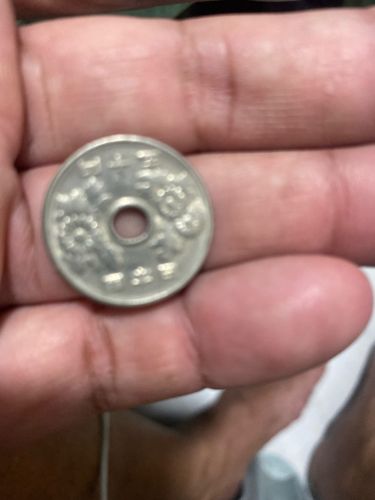5 Yen Coin (Gonen)
Country of Origin: Japan
Year of Issue: Shōwa Year 24-Present (1949-Present, though the image appears to be a modern version after 1959)
Denomination: 5 Yen
Composition: Brass (60-70% Copper, 30-40% Zinc)

Brief Description
The coin features a hole in the center, which is a distinctive characteristic. The obverse depicts a rice stalk (symbolizing agriculture and prosperity) above the central hole, and water (representing fisheries) below it. Kanji characters for '5 Yen' are written around the hole. The reverse features a gear (symbolizing industry) around the hole, with the year of minting in Kanji at the bottom and 'Japan' (日本国 Nihon-koku) at the top.
Historical Significance
The 5 Yen coin, especially with the hole, is culturally significant in Japan. The word for '5 yen' (go-en 五円) is a homophone for 'go-en' (御縁), which means 'good luck' or 'good relationships/connections'. Because of this, it is commonly offered at Shinto shrines, temples, or given as a good luck charm. The hole design was introduced in 1949 and changed slightly in 1959 to its current brass composition, making it easily distinguishable. The imagery of rice, water, and industry represents key aspects of the Japanese economy and culture.
Estimated Value
Circulated modern 5 yen coins (post-1959) are generally worth their face value, which is approximately 0.03-0.04 USD. Uncirculated or older issues (1949-1958) can be worth slightly more to collectors, ranging from a few cents to a few dollars depending on rarity and condition.
Care Instructions
Like most coins, it's best to handle 5 yen coins by their edges to avoid transferring oils from your skin, which can cause discoloration over time. Store them in a dry, stable environment, preferably in coin holders or albums designed for numismatic items to protect them from scratches and environmental damage. Avoid cleaning them unless you are an expert, as improper cleaning can significantly reduce their value.
Created At: 2025-10-26T13:18:31.425673